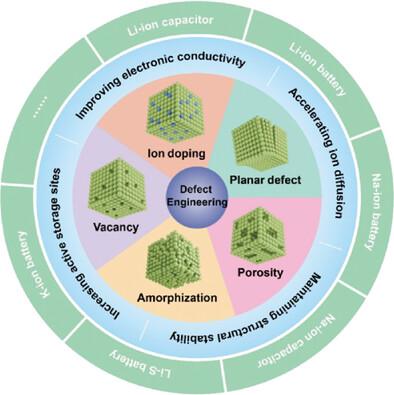电化学储能用五氧化二铌缺陷工程研究进展
IF 13
2区 材料科学
Q1 CHEMISTRY, MULTIDISCIPLINARY
引用次数: 0
摘要
合理设计先进的电化学储能(EES)负极材料对于加快可再生能源技术的发展至关重要。Nb2O5作为阳极的候选材料引起了越来越多的研究关注。缺陷工程被认为是调节Nb2O5内部局部原子结构的可行方法。因此,在Nb2O5中引入缺陷被认为是一种很有前途的提高电化学性能的方法。然而,对于Nb2O5在储能过程中的缺陷工程,目前还没有系统的综述。本文首先系统地分析了Nb2O5的晶体结构和储能机理。随后,系统总结了用于EES器件的Nb2O5缺陷工程的最新进展,主要集中在空位调制、离子掺杂、平面缺陷、引入孔隙和非晶化等方面。特别值得注意的是缺陷工程对Nb2O5的影响:改善电子导电性,加速离子扩散,保持结构稳定性,增加活性存储位点。本文进一步总结了Nb2O5中诱导缺陷的各种方法和常用的缺陷表征技术。最后,本文提出了Nb2O5缺陷工程目前面临的挑战,并概述了未来的发展前景,以实现具有高能量和功率密度的高性能EES器件。本文章由计算机程序翻译,如有差异,请以英文原文为准。

Advances on Defect Engineering of Niobium Pentoxide for Electrochemical Energy Storage
The reasonable design of advanced anode materials for electrochemical energy storage (EES) devices is crucial in expediting the progress of renewable energy technologies. Nb2O5 has attracted increasing research attention as an anode candidate. Defect engineering is regarded as a feasible approach to modulate the local atomic configurations within Nb2O5. Therefore, introducing defects into Nb2O5 is considered to be a promising way to enhance electrochemical performance. However, there is no systematic review on the defect engineering of Nb2O5 for the energy storage process. This review systematically analyzes first the crystal structures and energy storage mechanisms of Nb2O5. Subsequently, a systematical summary of the latest advances in defect engineering of Nb2O5 for EES devices is presented, mainly focusing on vacancy modulation, ion doping, planar defects, introducing porosity, and amorphization. Of particular note is the effects of defect engineering on Nb2O5: improving electronic conductivity, accelerating ion diffusion, maintaining structural stability, increasing active storage sites. The review further summarizes diverse methodologies for inducing defects and the commonly used techniques for the defect characterization within Nb2O5. In conclusion, the article proposes current challenges and outlines future development prospects for defect engineering in Nb2O5 to achieve high-performance EES devices with both high energy and power densities.
求助全文
通过发布文献求助,成功后即可免费获取论文全文。
去求助
来源期刊

Small
工程技术-材料科学:综合
CiteScore
17.70
自引率
3.80%
发文量
1830
审稿时长
2.1 months
期刊介绍:
Small serves as an exceptional platform for both experimental and theoretical studies in fundamental and applied interdisciplinary research at the nano- and microscale. The journal offers a compelling mix of peer-reviewed Research Articles, Reviews, Perspectives, and Comments.
With a remarkable 2022 Journal Impact Factor of 13.3 (Journal Citation Reports from Clarivate Analytics, 2023), Small remains among the top multidisciplinary journals, covering a wide range of topics at the interface of materials science, chemistry, physics, engineering, medicine, and biology.
Small's readership includes biochemists, biologists, biomedical scientists, chemists, engineers, information technologists, materials scientists, physicists, and theoreticians alike.
 求助内容:
求助内容: 应助结果提醒方式:
应助结果提醒方式:


